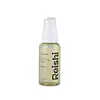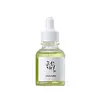What's inside
What's inside
 Key Ingredients
Key Ingredients

 Benefits
Benefits

 Ingredients Side-by-side
Ingredients Side-by-side

Ganoderma Lucidum Extract 65%
Skin ProtectingButylene Glycol
HumectantGlycerin
HumectantLactobacillus Ferment
Skin ConditioningWater
Skin ConditioningNiacinamide
SmoothingGlycereth-26
Humectant1,2-Hexanediol
Skin ConditioningCaprylyl Glycol
EmollientHydroxyacetophenone
AntioxidantPentylene Glycol
Skin ConditioningXanthan Gum
EmulsifyingEthylhexylglycerin
Skin ConditioningAllantoin
Skin ConditioningBetaine
HumectantDipotassium Glycyrrhizate
HumectantInonotus Obliquus Extract
Skin ConditioningTremella Fuciformis Extract
HumectantCamellia Sinensis Leaf Extract
AntimicrobialAdenosine
Skin ConditioningSodium Hyaluronate
HumectantLactococcus Ferment Lysate
Skin ConditioningSaccharomyces Ferment
Skin ConditioningStreptococcus Thermophilus Ferment
HumectantBacillus Ferment
Skin ConditioningGanoderma Lucidum Extract 65%, Butylene Glycol, Glycerin, Lactobacillus Ferment, Water, Niacinamide, Glycereth-26, 1,2-Hexanediol, Caprylyl Glycol, Hydroxyacetophenone, Pentylene Glycol, Xanthan Gum, Ethylhexylglycerin, Allantoin, Betaine, Dipotassium Glycyrrhizate, Inonotus Obliquus Extract, Tremella Fuciformis Extract, Camellia Sinensis Leaf Extract, Adenosine, Sodium Hyaluronate, Lactococcus Ferment Lysate, Saccharomyces Ferment, Streptococcus Thermophilus Ferment, Bacillus Ferment
Camellia Sinensis Leaf Water
MaskingWater
Skin ConditioningPanthenol
Skin ConditioningGlycerin
HumectantButylene Glycol
Humectant1,2-Hexanediol
Skin ConditioningMethylpropanediol
SolventAcrylates/C10-30 Alkyl Acrylate Crosspolymer
Emulsion StabilisingTromethamine
BufferingBetaine
HumectantEthylhexylglycerin
Skin ConditioningAllantoin
Skin ConditioningDipotassium Glycyrrhizate
HumectantArtemisia Capillaris Extract
Glyceryl Acrylate/Acrylic Acid Copolymer
HumectantMelia Azadirachta Leaf Extract
Skin ConditioningPolyquaternium-51
Skin ConditioningMalt Extract
Skin ProtectingMelia Azadirachta Flower Extract
Skin ConditioningCoptis Japonica Root Extract
Skin ConditioningSodium Hyaluronate
HumectantCamellia Sinensis Leaf Water, Water, Panthenol, Glycerin, Butylene Glycol, 1,2-Hexanediol, Methylpropanediol, Acrylates/C10-30 Alkyl Acrylate Crosspolymer, Tromethamine, Betaine, Ethylhexylglycerin, Allantoin, Dipotassium Glycyrrhizate, Artemisia Capillaris Extract, Glyceryl Acrylate/Acrylic Acid Copolymer, Melia Azadirachta Leaf Extract, Polyquaternium-51, Malt Extract, Melia Azadirachta Flower Extract, Coptis Japonica Root Extract, Sodium Hyaluronate
 Reviews
Reviews

Ingredients Explained
These ingredients are found in both products.
Ingredients higher up in an ingredient list are typically present in a larger amount.
1,2-Hexanediol is a synthetic liquid and another multi-functional powerhouse.
It is a:
- Humectant, drawing moisture into the skin
- Emollient, helping to soften skin
- Solvent, dispersing and stabilizing formulas
- Preservative booster, enhancing the antimicrobial activity of other preservatives
Allantoin is a soothing ingredient known for its protective and moisturizingg properties. Because of this, it is often added to products with strong active ingredients.
Studies show higher concentrations of this ingredient can promote wound healing.
Though it can be derived from the comfrey plant, allantoin is produced synthetically for cosmetic products to ensure purity.
Learn more about AllantoinBetaine is a common humectant (a substance that promotes retention of moisture). It's known to be gentle on the skin and can help balance hydration.
This ingredient is best for improving hydration and soothing irritated skin. Studies also show it helps even out skin tone.
Fun fact: Betaine is naturally created in the skin and body. The kind found within cosmetic products can be either plant-derived or synthetic.
Another name for betaine is trimethylglycine.
Learn more about BetaineButylene Glycol (or BG) is used within cosmetic products for a few different reasons:
Overall, Butylene Glycol is a safe and well-rounded ingredient that works well with other ingredients.
Though this ingredient works well with most skin types, some people with sensitive skin may experience a reaction such as allergic rashes, closed comedones, or itchiness.
Learn more about Butylene GlycolDipotassium Glycyrrhizate comes from licorice root.
Extracts of licorice have demonstrated to have antibacterial, anti‐inflammatory, antiviral, antioxidant properties.
One component, glabridin, has extra potent antioxidant and soothing properties. It has also been found to block pigmentation from UVB rays in guinea pigs.
Licorice Root also contains a flavonoid. Flavonoids are a natural substance from in plants. Flavonoids also have antioxidant properties.
Another component, glycyrrhizin, has been found to have anti-inflammatory and antimicrobial benefits. This may make licorice root extract effective at treating acne. However, more research is needed to support this.
Liquiritin is one of the flavone compounds found in licorice. It has been found to help lighten skin by preventing tyrosinase from reacting with tyrosine. When the two react, protein is converted to melanin. Melanin is the substance in your body that gives your features pigmentation.
Licorice root is native to Southern Europe and Asia. It has been used in traditional Chinese medicine to help with respiratory issues.
Learn more about Dipotassium GlycyrrhizateEthylhexylglycerin (we can't pronounce this either) is commonly used as a preservative and skin softener. It is derived from glyceryl.
You might see Ethylhexylglycerin often paired with other preservatives such as phenoxyethanol. Ethylhexylglycerin has been found to increase the effectiveness of these other preservatives.
Glycerin is already naturally found in your skin. It helps moisturize and protect your skin.
A study from 2016 found glycerin to be more effective as a humectant than AHAs and hyaluronic acid.
As a humectant, it helps the skin stay hydrated by pulling moisture to your skin. The low molecular weight of glycerin allows it to pull moisture into the deeper layers of your skin.
Hydrated skin improves your skin barrier; Your skin barrier helps protect against irritants and bacteria.
Glycerin has also been found to have antimicrobial and antiviral properties. Due to these properties, glycerin is often used in wound and burn treatments.
In cosmetics, glycerin is usually derived from plants such as soybean or palm. However, it can also be sourced from animals, such as tallow or animal fat.
This ingredient is organic, colorless, odorless, and non-toxic.
Glycerin is the name for this ingredient in American English. British English uses Glycerol/Glycerine.
Learn more about GlycerinSodium Hyaluronate is hyaluronic acid's salt form. It is commonly derived from the sodium salt of hyaluronic acid.
Like hyaluronic acid, it is great at holding water and acts as a humectant. This makes it a great skin hydrating ingredient.
Sodium Hyaluronate is naturally occurring in our bodies and is mostly found in eye fluid and joints.
These are some other common types of Hyaluronic Acid:
Learn more about Sodium HyaluronateWater. It's the most common cosmetic ingredient of all. You'll usually see it at the top of ingredient lists, meaning that it makes up the largest part of the product.
So why is it so popular? Water most often acts as a solvent - this means that it helps dissolve other ingredients into the formulation.
You'll also recognize water as that liquid we all need to stay alive. If you see this, drink a glass of water. Stay hydrated!
Learn more about Water